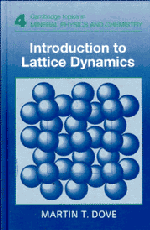Book contents
- Frontmatter
- Contents
- Preface
- Acknowledgements
- Physical constants and conversion factors
- 1 Some fundamentals
- 2 The harmonic approximation and lattice dynamics of very simple systems
- 3 Dynamics of diatomic crystals: general principles
- 4 How far do the atoms move?
- 5 Lattice dynamics and thermodynamics
- 6 Formal description
- 7 Acoustic modes and macroscopic elasticity
- 8 Anharmonic effects and phase transitions
- 9 Neutron scattering
- 10 Infrared and Raman spectroscopy
- 11 Formal quantum-mechanical description of lattice vibrations
- 12 Molecular dynamics simulations
- A The Ewald method
- B Lattice sums
- C Bose-Einstein distribution and the thermodynamic relations for phonons
- D Landau theory of phase transitions
- E Classical theory of coherent neutron scattering
- F Time correlation functions
- G Commutation relations
- H Published phonon dispersion curves for non-metallic crystals: update of previous compilation
- References
- Index
Preface
Published online by Cambridge University Press: 17 February 2010
- Frontmatter
- Contents
- Preface
- Acknowledgements
- Physical constants and conversion factors
- 1 Some fundamentals
- 2 The harmonic approximation and lattice dynamics of very simple systems
- 3 Dynamics of diatomic crystals: general principles
- 4 How far do the atoms move?
- 5 Lattice dynamics and thermodynamics
- 6 Formal description
- 7 Acoustic modes and macroscopic elasticity
- 8 Anharmonic effects and phase transitions
- 9 Neutron scattering
- 10 Infrared and Raman spectroscopy
- 11 Formal quantum-mechanical description of lattice vibrations
- 12 Molecular dynamics simulations
- A The Ewald method
- B Lattice sums
- C Bose-Einstein distribution and the thermodynamic relations for phonons
- D Landau theory of phase transitions
- E Classical theory of coherent neutron scattering
- F Time correlation functions
- G Commutation relations
- H Published phonon dispersion curves for non-metallic crystals: update of previous compilation
- References
- Index
Summary
The subject of lattice dynamics is taught in most undergraduate courses in solid state physics, usually to a very simple level. The theory of lattice dynamics is also central to many aspects of research into the behaviour of solids. In writing this book I have tried to include among the readership both undergraduate and graduate students, and established research workers who find themselves needing to get to grips with the subject.
A large part of the book (Chapters 1–9) is based on lectures I have given to second and third year undergraduates at Cambridge, and is therefore designed to be suitable for teaching lattice dynamics as part of an undergraduate degree course in solid state physics or chemistry. Where I have attempted to make the book more useful for teaching lattice dynamics than many conventional solid state physics textbooks is in using real examples of applications of the theory to materials more complex than simple metals.
I perceive that among research workers there will be two main groups of readers. The first contains those who use lattice dynamics for what I might call modelling studies. Calculations of vibrational frequencies provide useful tests of any proposed model interatomic interaction. Given a working microscopic model, lattice dynamics calculations enable the calculation of macroscopic thermodynamic properties. The systems that are tackled are usually more complex than the simple examples used in elementary texts, yet the theoretical methods do not need the sophistication found in more advanced texts. Therefore this book aims to be a half-way house, attempting to keep the theory at a sufficiently low level, but developed in such a way that its application to complex systems is readily understood.
- Type
- Chapter
- Information
- Introduction to Lattice Dynamics , pp. xiii - xvPublisher: Cambridge University PressPrint publication year: 1993

